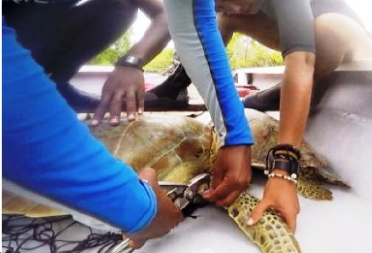Aldabra turtle database completed with new data tools |21 August 2017
Turtle emergence and nesting data has been regularly collected on Aldabra since 1996, but because of progress in computing and technology over the last 21 years, data collection and storage methods have changed markedly.
Initially stored on paper, and then in several types of database programme, the latest iteration is a user-friendly relational database designed to standardise data, and to make data entry quicker and easier for staff, as well as to minimise errors.

Not only was the new database designed from scratch, but all historical data (some 2.5 million data points) had to be cleaned and modified to fit the new format; a time-consuming task, but a worthwhile one! When turtles are encountered while nesting, they are given two numbered titanium ID tags, one in each flipper. Should one of these come out, the turtle is re-tagged on that flipper next time it is seen, meaning that turtles’ tag numbers can change over time. Now, for the first time, turtles are automatically assigned a unique ID upon first capture to better enable temporal tracking (this has also been applied retroactively to all data) no matter how much the tags may change over time.
Now, by simply typing in one of the tag codes, users are able to track the emergence history of each tagged turtle, including when they were first tagged, every time they were seen nesting, and how their shell measurements have changed over time.
The way data is physically collected has also changed; we now collect our daily emergence count data on a Trimble - a rugged, handheld computer – which we are able to directly upload to the database, saving time, paper and limiting data transcription errors ensuring our data is as accurate as possible.





